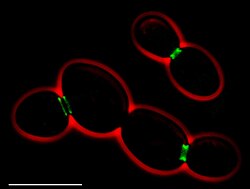In biology, a septum (Latin for something that encloses; pl.septa) is a wall, dividing a cavity or structure into smaller ones. A cavity or structure divided in this way may be referred to as septate.
In biology, a septum (Latin for something that encloses; pl.septa) is a wall, dividing a cavity or structure into smaller ones. A cavity or structure divided in this way may be referred to as septate.



Histological septa are seen throughout most tissues of the body, particularly where they are needed to stiffen soft cellular tissue, and they also provide planes of ingress for small blood vessels.[ citation needed ] Because the dense collagen fibres of a septum usually extend out into the softer adjacent tissues, microscopic fibrous septa are less clearly defined than the macroscopic types of septa listed above. [13] In rare instances, a septum is a cross-wall. Thus it divides a structure into smaller parts. [14]
The septum (cell biology) is the boundary formed between dividing cells in the course of cell division. [15]



A coral septum is one of the radial calcareous plates in the corallites of a coral. [18]
Annelids have septa that divide their coelom into segmented chambers. [19]
Many shelled organisms have septa subdividing their shell chamber, including rhizopods, cephalopods and gastropods, the latter seemingly serving as a defence against shell-boring predators. [20] [21]
{{cite journal}}: CS1 maint: DOI inactive as of July 2025 (link)